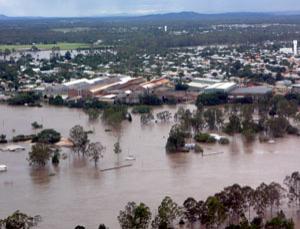Climate change blamed for Australia's extreme weather
 The east coast of Australia has been drenched by floods and torrential rains, even as recent bush fires affecting much of the country continued to burn. Four people are known to have died as Australians get a further taste of extreme weather that is predicted to become more common as the planet warms.
The east coast of Australia has been drenched by floods and torrential rains, even as recent bush fires affecting much of the country continued to burn. Four people are known to have died as Australians get a further taste of extreme weather that is predicted to become more common as the planet warms.The deluge came as a storm that started as tropical cyclone Oswald just north of Australia was dragged south over most of the east coast by a low-pressure system extending all the way to New South Wales, says Richard Wardle of the Bureau of Meteorology in Queensland. As it hit land, Oswald lost its cyclone status but remained a “vigorous” storm, Wardle says.
With no low-pressure zone further east to pull Oswald out to sea, the storm stayed over land, moving slowly south and dumping huge amounts of rain on coastal communities. Bundaberg, a town in Queensland, experienced its worst-ever flood as the storm lingered nearby for nearly 24 hours, leading to the evacuation of 7500 people from their homes. In Brisbane, the floods were almost as bad as those that devastated the city two years ago.
Climate change to blame
In Queensland and New South Wales, the deluge arrived while the bush fires that broke out two weeks were still smouldering. At the time, the Bureau of Meteorology said that the exceptionally hot, dry weather that led to the fires was “consistent” with climate change. Experts are now drawing the same conclusions about the rains.
“The frequency of more intense events is going to increase. Droughts, heatwaves and – in northern Australia – rainfall events and tropical cyclones are going to be more intense,” says Jon Nott of James Cook University in Townsville, Australia, who researches extreme weather events.
Nott says that more intense rainfall in the tropics and subtropics is one of the things we can expect with global warming. The connection between tropical cyclones and climate change is complicated: fewer cyclones are expected, but the ones that strike will be more severe. They could also become 20 per cent wetter.
Nott points out that Australia might be experiencing a “double whammy” of climate change and natural variability, driving wetter conditions. One natural pattern, the Interdecadal Pacific Oscillation, affects circulation in the Pacific, and reverses every 20 or 30 years. It flipped about five years ago for the first time since 1977, bringing warmer waters to Australia’s east coast. “During those phases, Queensland sees more flooding, more rainfall, and more landfalling tropical cyclones,” Nott says. Climate change will only compound the effects of such patterns, he says.
You can return to the main Market News page, or press the Back button on your browser.

